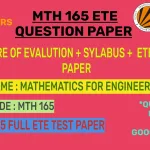CSIR NET Mathematics exam is an important step for candidates aspiring to work in research and development. It assesses a wide range of mathematical concepts through various question types. In this article, we cover a detailed analysis of previous year’s question papers with answers, which will help in preparation.
CSIR NET Mathematics: Previous Year Questions and Answers
The CSIR NET (Council of Scientific and Industrial Research National Eligibility Test) in Mathematics evaluates candidates’ proficiency in various mathematical concepts. The exam includes multiple sections covering topics such as Algebra, Analysis, Differential Equations, and more. Below are some of the previous year’s questions, which will help in your preparation.
Question 1:
What is the general solution of the differential equation dydx=y\frac{dy}{dx} = y?
Answer:
The general solution is y=Cexy = Ce^x, where CC is the constant of integration.
Question 2:
If f(x)=∫0xet2dtf(x) = \int_{0}^{x} e^{t^2} dt, then what is the value of f′(x)f'(x)?
Answer:
By the Fundamental Theorem of Calculus, f′(x)=ex2f'(x) = e^{x^2}.
Question 3:
Find the eigenvalues of the matrix
A=(2112)A = \begin{pmatrix} 2 & 1 \\ 1 & 2 \end{pmatrix}
Answer:
The eigenvalues of the matrix are λ=3\lambda = 3 and λ=1\lambda = 1.
Question 4:
What is the Fourier series expansion of f(x)=x2f(x) = x^2 in the interval [−L,L][-L, L]?
Answer:
The Fourier series expansion of f(x)=x2f(x) = x^2 is
f(x)=L23+∑n=1∞((−1)n4L2n2π2)cos(nπxL)f(x) = \frac{L^2}{3} + \sum_{n=1}^{\infty} \left( \frac{(-1)^n 4L^2}{n^2 \pi^2} \right) \cos\left(\frac{n \pi x}{L}\right)
Question 5:
Find the solution to the second-order linear differential equation
y′′−4y′+4y=0y” – 4y’ + 4y = 0
Answer:
The solution to the differential equation is
y=(C1+C2x)e2xy = (C_1 + C_2 x)e^{2x}
Question 6:
If f(x)=x3+3×2+2x+1f(x) = x^3 + 3x^2 + 2x + 1, what is f′(x)f'(x)?
Answer:
The derivative f′(x)=3×2+6x+2f'(x) = 3x^2 + 6x + 2.
Question 7:
State the Cayley-Hamilton theorem.
Answer:
The Cayley-Hamilton theorem states that every square matrix satisfies its own characteristic equation.
Question 8:
What is the radius of convergence of the series
∑n=1∞xnn!\sum_{n=1}^{\infty} \frac{x^n}{n!}
Answer:
The radius of convergence of this series is infinite.
Question 9:
Find the solution of the system of equations
(1234)(xy)=(56)\begin{pmatrix} 1 & 2 \\ 3 & 4 \end{pmatrix} \begin{pmatrix} x \\ y \end{pmatrix} = \begin{pmatrix} 5 \\ 6 \end{pmatrix}
Answer:
The solution to the system is x=4x = 4 and y=−1y = -1.
Question 10:
What is the value of the integral
∫01e−x2dx\int_{0}^{1} e^{-x^2} dx
Answer:
The integral ∫01e−x2dx\int_{0}^{1} e^{-x^2} dx is approximately 0.74682.
Question 11:
Define a Banach space.
Answer:
A Banach space is a complete normed vector space, meaning that it is a vector space in which every Cauchy sequence converges to an element of the space.
Question 12:
Find the Fourier transform of the function f(t)=e−atf(t) = e^{-at}, where a>0a > 0.
Answer:
The Fourier transform of f(t)=e−atf(t) = e^{-at} is
F(ω)=1a+iωF(\omega) = \frac{1}{a + i \omega}
Question 13:
What is the determinant of the matrix
(100020003)\begin{pmatrix} 1 & 0 & 0 \\ 0 & 2 & 0 \\ 0 & 0 & 3 \end{pmatrix}
Answer:
The determinant of the matrix is 6.
Question 14:
What is the gradient of the function f(x,y)=x2+y2f(x, y) = x^2 + y^2?
Answer:
The gradient of f(x,y)f(x, y) is ∇f(x,y)=(2x,2y)\nabla f(x, y) = (2x, 2y).
Question 15:
Evaluate the limit
limx→0sin(x)x\lim_{x \to 0} \frac{\sin(x)}{x}
Answer:
The limit is 1.
Question 16:
What is the characteristic polynomial of the matrix
(1234)\begin{pmatrix} 1 & 2 \\ 3 & 4 \end{pmatrix}
Answer:
The characteristic polynomial is λ2−5λ−2=0\lambda^2 – 5\lambda – 2 = 0.
Question 17:
If f(x)=x4−2×2+1f(x) = x^4 – 2x^2 + 1, find the second derivative of f(x)f(x).
Answer:
The second derivative of f(x)f(x) is f′′(x)=12×2−4f”(x) = 12x^2 – 4.
Question 18:
Solve the equation x2+4x+3=0x^2 + 4x + 3 = 0.
Answer:
The solutions to the equation are x=−1x = -1 and x=−3x = -3.
Question 19:
What is the Taylor series expansion of exe^x around x=0x = 0?
Answer:
The Taylor series expansion of exe^x around x=0x = 0 is
ex=1+x+x22!+x33!+⋯e^x = 1 + x + \frac{x^2}{2!} + \frac{x^3}{3!} + \cdots
Question 20:
Find the inverse of the matrix
A=(1234)A = \begin{pmatrix} 1 & 2 \\ 3 & 4 \end{pmatrix}
Answer:
The inverse of the matrix is
A−1=1−2(4−2−31)A^{-1} = \frac{1}{-2} \begin{pmatrix} 4 & -2 \\ -3 & 1 \end{pmatrix}
Practicing previous year question papers is one of the best ways to prepare for the CSIR NET Mathematics exam. Reviewing the solutions helps in understanding complex topics and refining problem-solving techniques. Regular practice and focused revision will greatly enhance your chances of success.
Latest Posts
- Step-by-step guide to download and apply for jee mains admit card 202
- Comprehensive 2025 government holidays and recruitment details for job seekers
- JEE Mains Admit Card 2025: Your Step-by-Step Guide to Downloading the Hall Ticket
- Everything You Need to Know About 2025 Government Holidays Recruitment
- Comprehensive Guide to rrb d group recruitment 2025 – Eligibility, Vacancies, and Application
- Detailed guide to nps trust recruitment 2025 vacancies, eligibility and apply process
- Comprehensive guide to hpcl recruitment 2025 notification, vacancies, and application process
- ignou bed admission 2025 complete recruitment guide with eligibility and process
- Comprehensive Guide to Indian Army Agniveer Recruitment 2025 Notification and Jobs
- Everything You Must Know About CBSE Board Exams 2025 Changes & New Rules






